Baskets in Georgia
Basketry is one of the oldest artforms practiced around the world to make objects for both function (used as tools) and pieces of art. Two communities in Georgia have unique basket traditions that help connect Georgia’s past and present. The Cherokee and Gullah Geechee people both contribute to our state’s history and illustrate how the movement of people away from their homelands has influenced today’s communities in Georgia. Because baskets are a craft at the heart of so many cultures, they can provide a touchable piece of a community that can come to represent the people themselves. Various basket forms, materials, and weaving techniques tell a story about the people who made them.
Live Zoom Lab
Woven History: Baskets of Georgia
Enjoy this live lab recording that guides you in weaving history and art together! New South historian Jenna Tran discusses the history of baskets in Georgia through the lens of the Cherokee and Gullah Geechee cultures. While you’re listening to Jenna, you can learn to weave your own basket! Anne Dorland, New South archaeologist and educator, shows you how to weave a basket using common household items. To view the activity plan and materials list, check out the Activity Plan PDF below. This activity is aligned with visual arts and/or social studies Georgia Department of Education Standards of Excellence for elementary, middle, and high school grade levels.
Activity Plan
New-Souths-Basketry-Activity-for-Camp-GPBCherokee Basketry and Oral Tradition
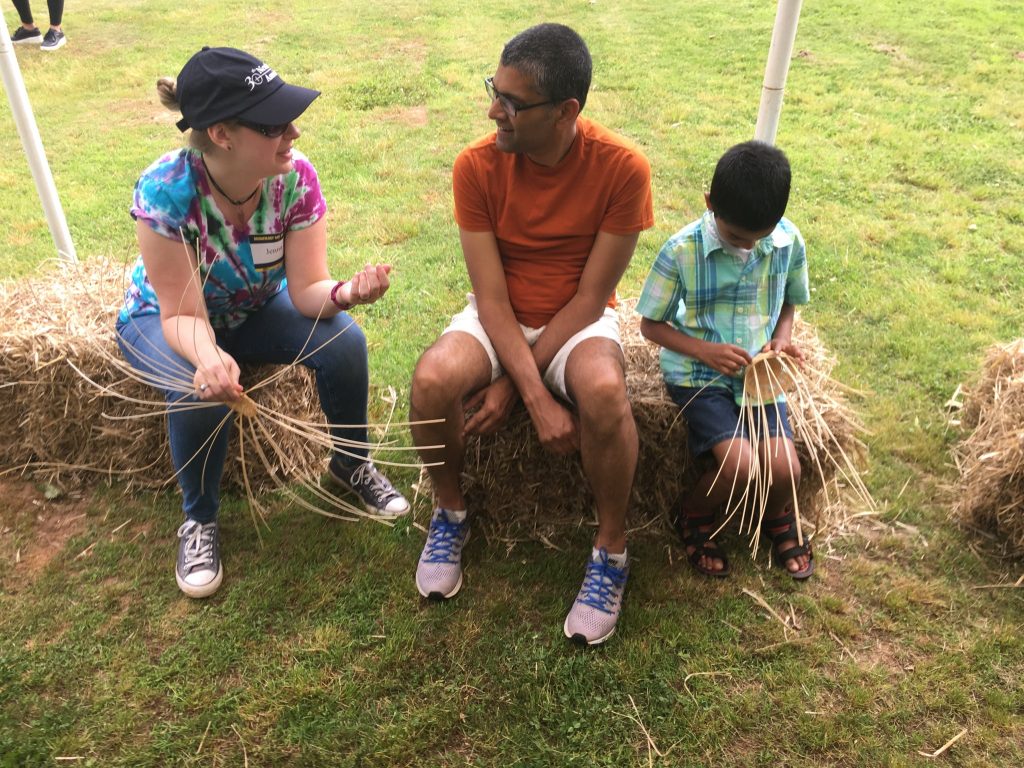
Today, there are three Cherokee tribes recognized by the federal government: the United Keetoowah Band of Cherokee Indians in Oklahoma, the Cherokee Nation in Oklahoma, and the Easter Band of Cherokee Indians in North Carolina. Historically, the Cherokee lived in the Southeastern U.S. before European contact. North Georgia was part of their homeland until the 1830s when the U.S. government forced the Keetoowah Band of Cherokee Indians and the Cherokee Nation to move to modern-day Oklahoma by way of the Trail of Tears. While relocation to Oklahoma and forced social reforms changed the basket tradition of the Cherokee, one aspect that remained the same is the unique double weave technique.
Cherokee oral tradition includes the story of the First Fire, which illustrates the importance of basket weaving:
Before the world had fire, it was cold and dark. One day, lightning struck from the sky and set fire to the hollow of a sycamore tree. The tree was on an island, surrounded by water. All the animals saw the fire and gathered to hold council on how to bring fire back to the mainland. After many of the animals tried and failed to bring the fire back, the water spider wove a tiny basket from her web. She glided across the water and carried back in her delicate basket a single coal from the sycamore tree. Thanks to the water spider and her skilled weaving, we have fire. (Abridged)
To read the unabridged version of the story of the First Fire, visit the Northern Cherokee Nation website.
Traditional Cherokee Basketry
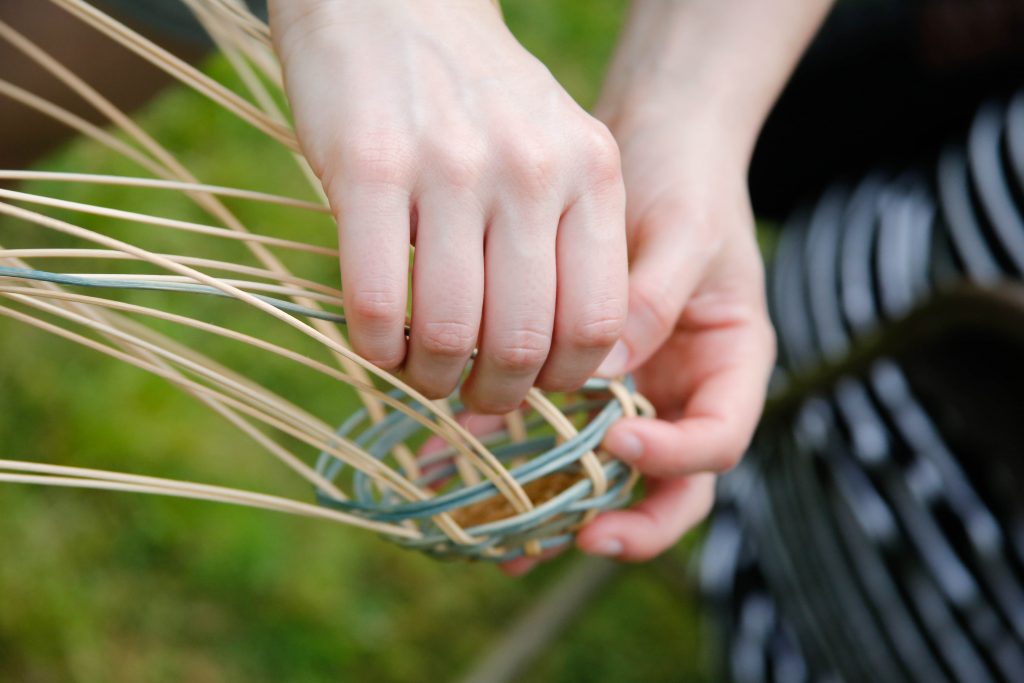
There are two types of weaving in Cherokee culture. The more traditional method uses river cane, which looks a lot like bamboo. Shawna and Roger Cain are experts in growing, harvesting, and weaving river cane baskets. Shawna Morton-Cain is a Cherokee National Treasure, a designation given to honor individuals who work to keep the art, language, and culture of the Cherokee Nation alive. Learn about river cane basket weaving in this article by Tahlequah Daily Press and in this Video by Shawna Cain on the Natural Processing of Cherokee Baskets.
Modern Cherokee Basketry Artists
TooNooWee Baskets are an American Indian art co-op from Oklahoma. All members are TERO (Tribal Employment Rights Office) Certified Cherokee Nation artists and tribal citizens. Artists Joshua Cooper and Talisha Lewallen Owens create art using contemporary Cherokee double weave basket technique. Check out the TooNooWee Baskets Instagram and TooNooWee Baskets Facebook pages to see some of their beautiful basketry.
In a 2016 article (Cherokee Phoenix: Cherokees Connect with Culture through Basketry), Cherokee artist Joshua Cooper conveyed how basket weaving allows him and his students to connect to their Cherokee culture and the sacrifices of their ancestors. Because the round reed style of basket weaving dates to the period following the Trail of Tears, weaving provides an opportunity to teach a skill and history at the same time. Like many American Indian artists, Cherokee basket weavers believe that their work helps to share their culture with the world and their own younger generation.
You can also check out the digital version of the Weaving History into Art: The Enduring Legacy of Shan Goshorn exhibit at Gilcrease Museum website. This exhibit features the art of Shan Goshorn (Eastern Band Cherokee, 1957-2018) and her legacy manifest through the works of four modern Native American female artists.
Early Stage of Cherokee Double Weave Basket Production
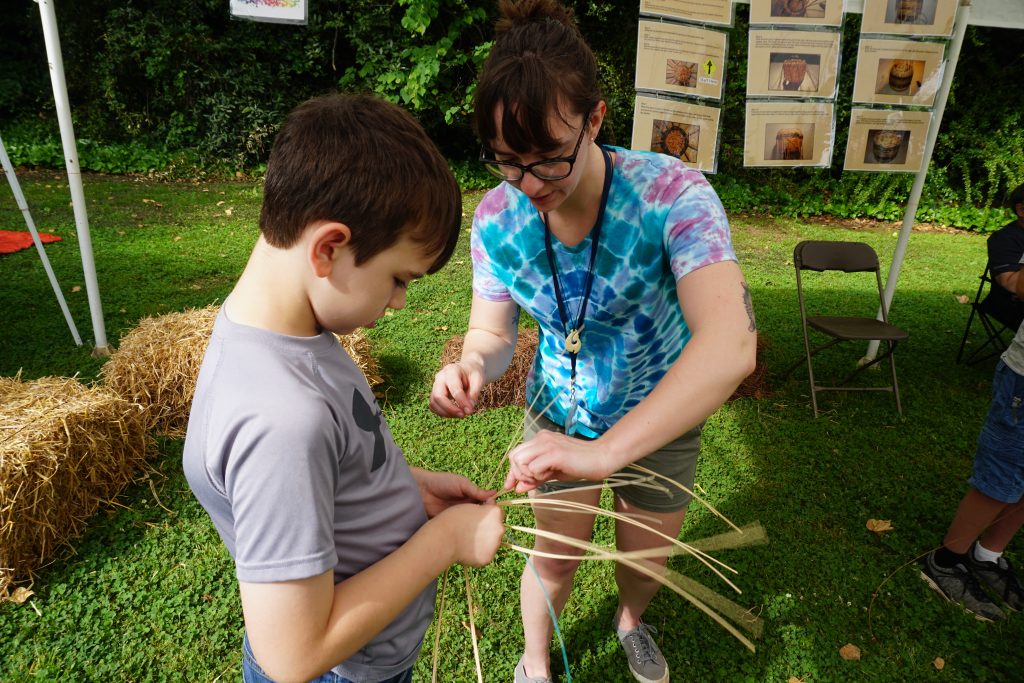
The tradition of weaving the double weave basket is an important characteristic of the history of the Cherokee. If you would like to learn more about the history of Cherokee Nation’s basket weaving traditions, check out this blog post by New South historian Jennifer Tran. Respond to the prompts below to test your knowledge! Interested in making your own basket? To learn how to get your basket started, watch this video made by the Cherokee Heritage Center: Culture Keepers: Basket Starts. In this video, you will learn the first step in making your own Cherokee double weave basket: weaving your base.
Sweetgrass Baskets and Gullah Geechee Culture
Gullah Geechee people are descendants of Africans who were enslaved on plantations along the eastern coast from North Carolina to Florida (including coastal Georgia). The isolation of the sea islands led the Gullah Geechee people to keep a deep connection to their native culture. They are most widely recognized for their sweetgrass baskets. This practice of basketry dates back to the 1600s and uses a technique of bundling the material and coiling it into circles that are lashed together with thin strands. Unlike other basket styles, the coiling of sweetgrass baskets is more like sewing than weaving.
What is Sweetgrass?
Early baskets were made from a hardy marsh grass called bulrush (cattails). By the 1900s, artists started using other materials such as pine needles, palmetto fronds, and sweetgrass. Sweetgrass is native plant more flexible than cattails and allowed for more creative designs like loops and handles. The palmetto fronds are used for the thin strips that sew the coils together and cattails and pine needles can be included for strength and decoration.
Want to learn more about Georgia basketry traditions?! Check out the Camp GPB Episode on the Art of Basketry, produced in collaboration with New South Associates!
Comparing Baskets of Georgia
While these two basket styles appear to be very different, the Cherokee and Gullah Geechee baskets have some important things in common.
- Both use plants native to the Southeastern United State. Cherokee baskets use rivercane, buckbrush, and honeysuckle as well as plants like black walnut and bloodroot for making dyes. Sweetgrass in native to the Sea Islands and the Gullah Geechee use palm fronds, cattails, and pine needles to adorn their baskets.
- Both cultures have been impacted by the forced movement of people. The Cherokee brought culturally significant plants with them when they were removed to Oklahoma. They also continued to use their double weave technique when new materials were introduced. The Gullah Geechee sweetgrass baskets bear a strong resemblance to the shukublay baskets of Sierra Leone in West Africa. Today’s baskets show a continuation of technique using materials from the New World.
- Both basket traditions are being impacted by changes to our environment. Climate change and development are threats to the native plants used to make baskets. Plants like rivercane and sweetgrass are becoming harder to find and access.
- Lastly, both the Cherokee and Gullah Geechee basket weavers are struggling to attract younger generations to the artform. The important oral tradition of handing down the knowledge and skill of weaving from parent to child lessens with each passing generation. Many artists will be the last in their family to weave.
Explore
There are places in Georgia you can visit to learn more about the Cherokee and Gullah Geechee communities of the past and present. The Chief Vann House in Chatsworth, Georgia is a State Historic Site and part of the Georgia Park System. The site includes a 1804 house, gardens, and museum exhibits that display artifacts from when nearby New Echota was the seat of the Cherokee government.
The Gullah Geechee Cultural Heritage Corridor is part of the National Park Service. It aims to preserve, share, and interpret the history, traditional cultural practices, heritage sites, and natural resources associated with the Gullah Geechee people.
Do you want to learn more about the Cherokee culture? The Smithsonian Institution has a collection of resources on Cherokee Native Americans. Visit this collection to learn about Cherokee food, art, language, and more!
Check out this Cherokee Nation Word of the Week video to learn the Cherokee word for basketry! Interested in learning more about the Cherokee language? You can take free online Cherokee language classes through RSU Public TV.
Advanced Activity
Make Your Own Newspaper Basket at Home!
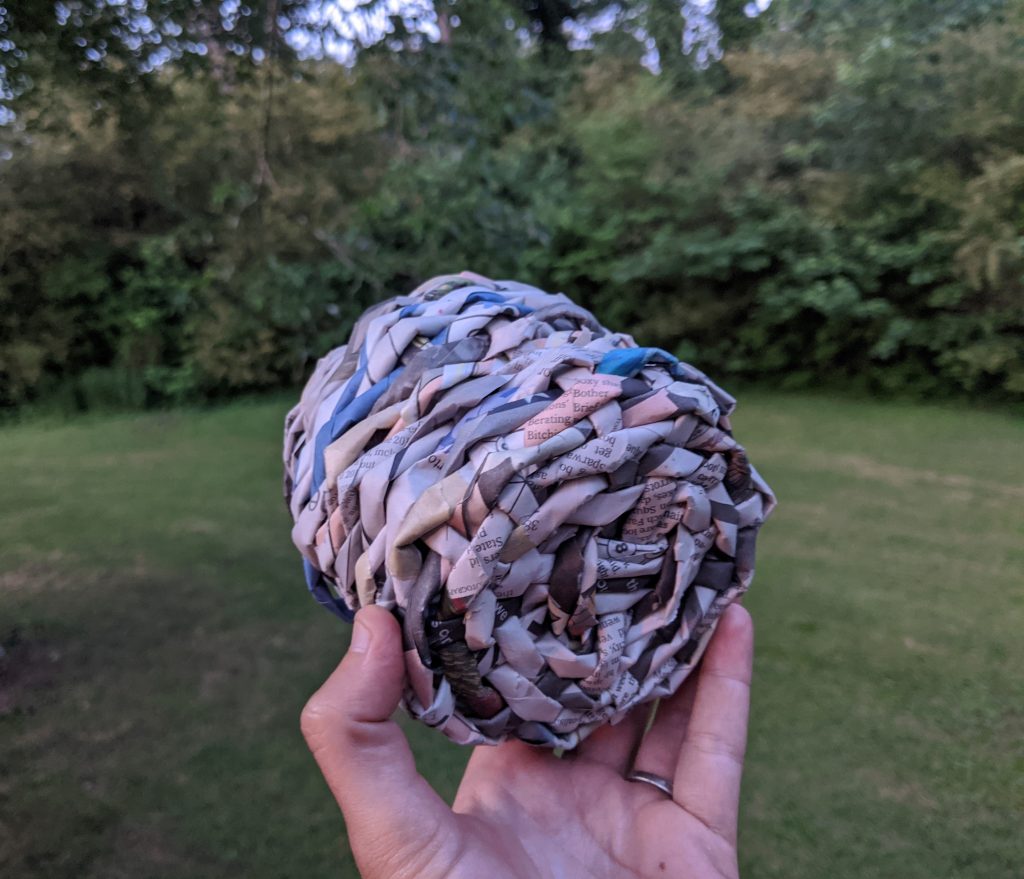
You can learn how to weave a basket using the common household items listed below. Please note that basket weaving takes patience and this activity is no different. While it can be tedious, basket weaving is very rewarding and we encourage you to take your time to learn this incredible skill!
Materials
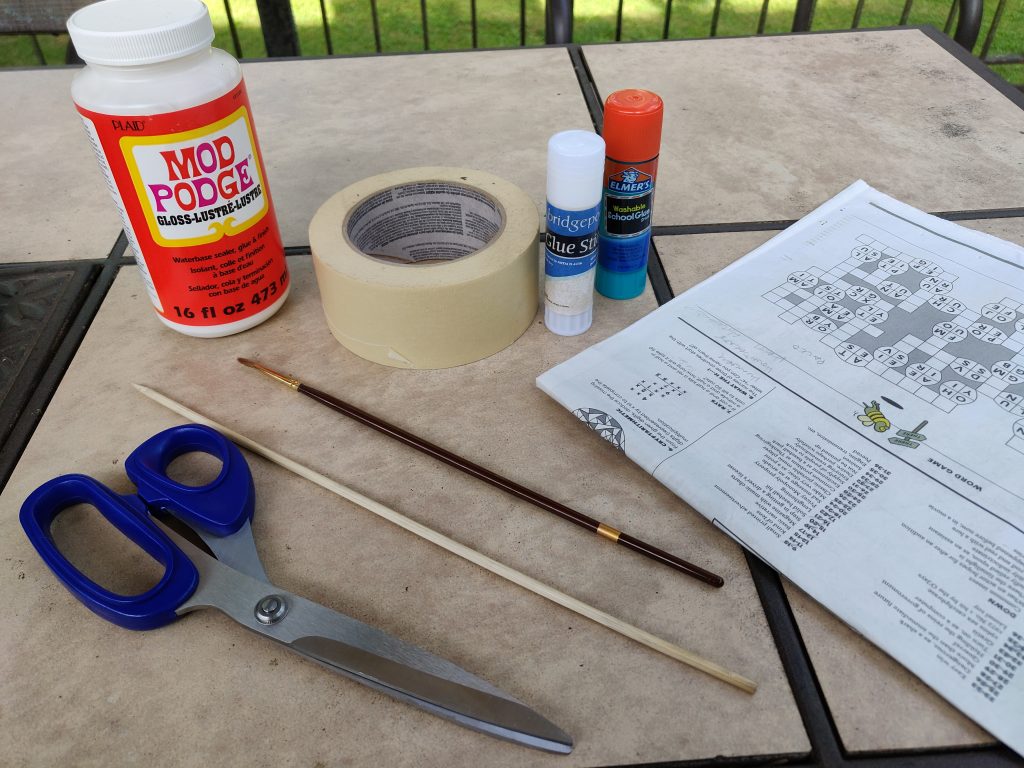
- Newspaper
- Scissors
- Wooden Skewer (or an item of similar length and diameter)
- Tape, glue, or Mod Podge
- Small paintbrush (only if using glue, Mod Podge, or paint)
- Paint (optional)
Instructions
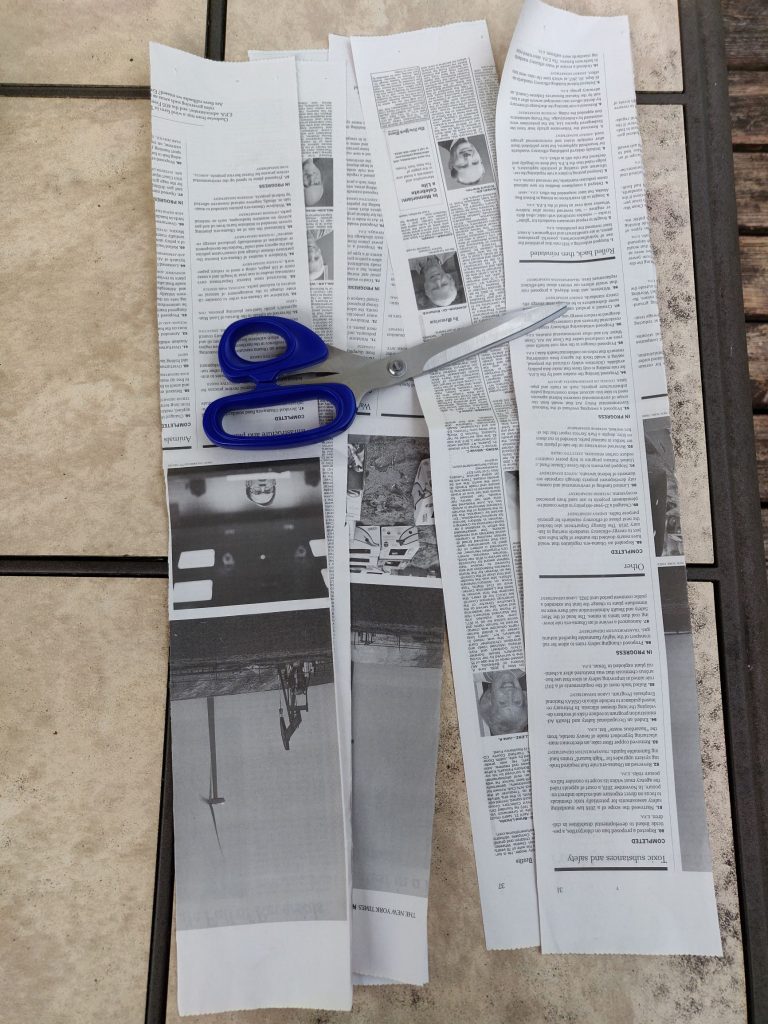
1. Separate the pages of a newspaper. Fold one page so that you have three long columns and cut along the fold lines, creating strips of about 3-4 inches wide. Repeat this process until you have about 20 strips of newspaper.
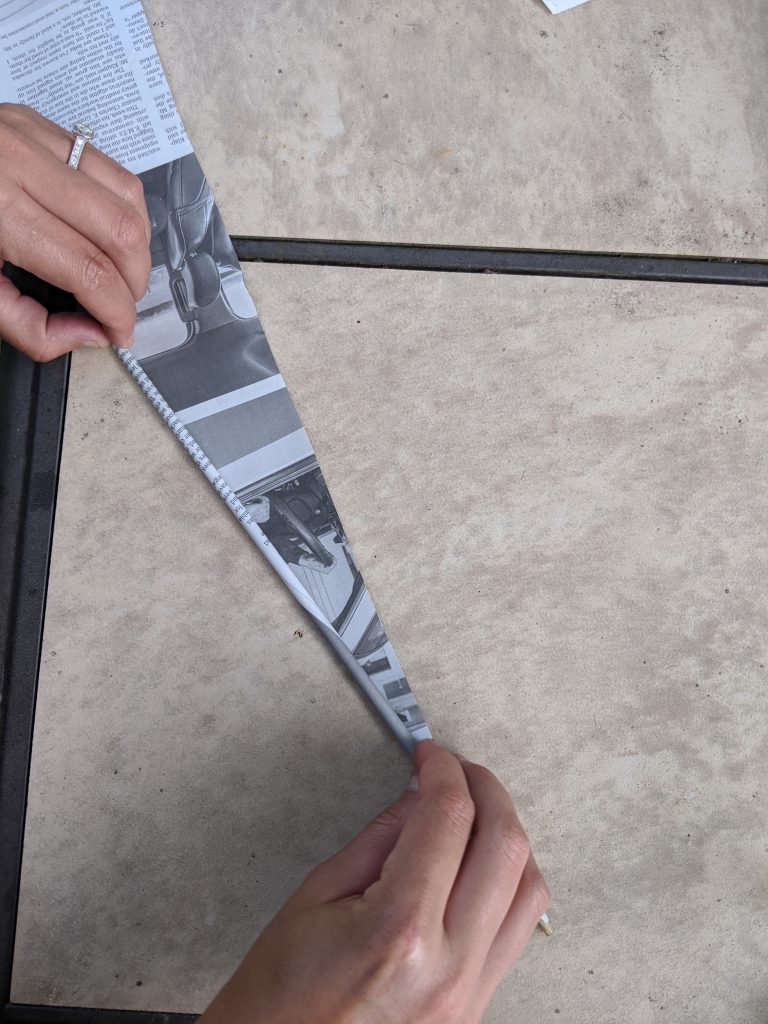
2. Using the skewer, or other thin stick, roll each strip of newspaper into a long tube. Start at a 45-degree angle and be sure to keep the paper taut as you roll it in order to create thin tubes with a consistent diameter. You do not want a conical tube. Use tape or glue to keep the newspaper rolls from unraveling. A dab of adhesive at the finishing corner should be held for about 30 seconds, or until it stays on its own. The adhesive should dry within a few minutes and will be ready to use once you have made several tubes.
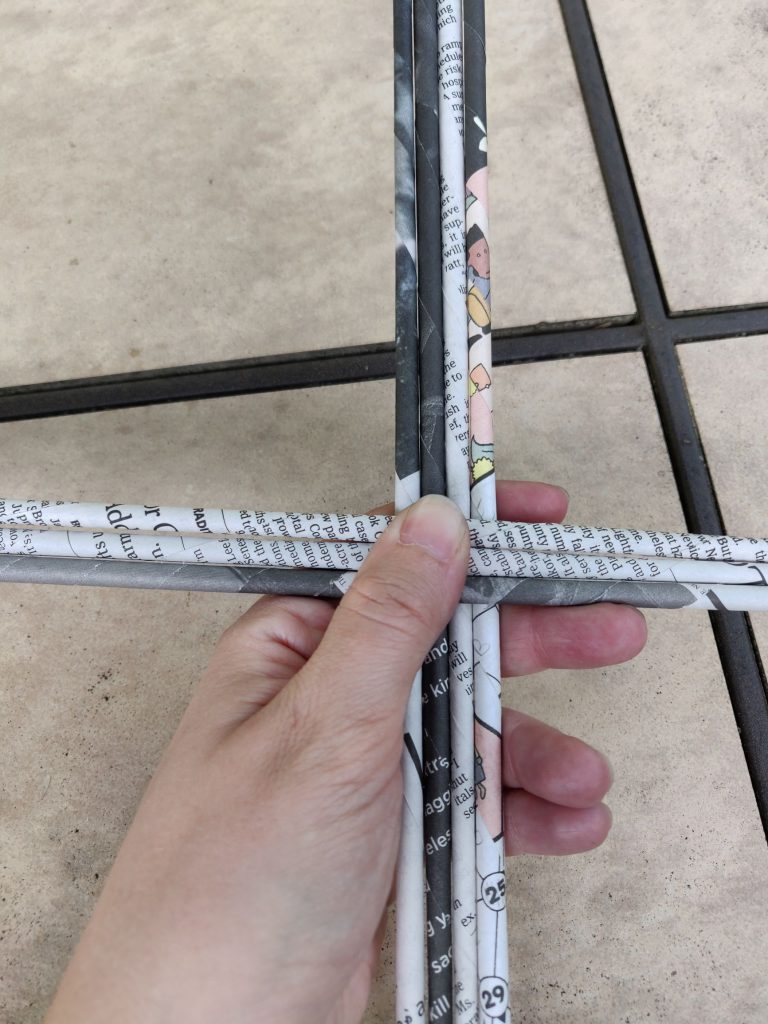
3. Seven of the tubes will serve as your basket spokes. Pick tubes that are similar in length to be the spokes, then split them into two sets: one set of three and one set of four. Create a cross shape with the two sets. The set of four should be under the set of three.
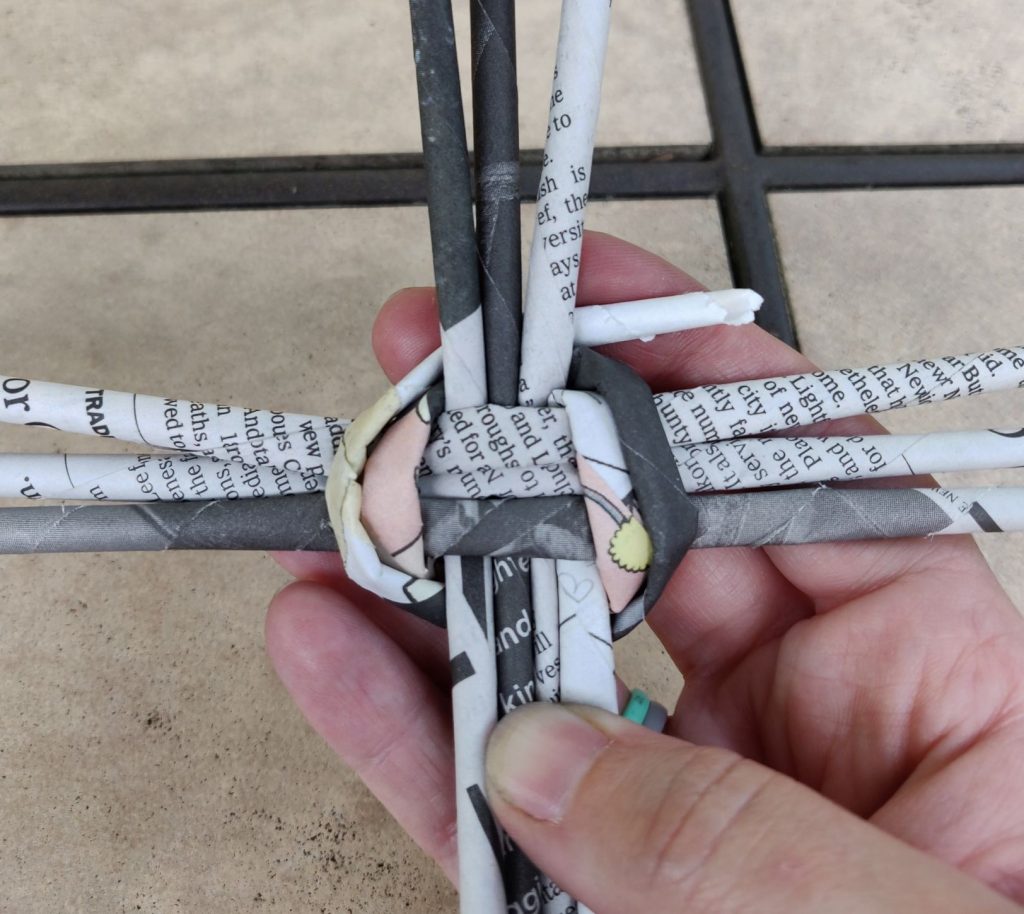
4. Take a tube from the bottom set of four tubes and bend it in half, down over the three tubes going the opposite direction. Then bend it under the next set and over the next set in a clockwise manner. You should be bending over and under in a way that lashes the sets of tubes together.
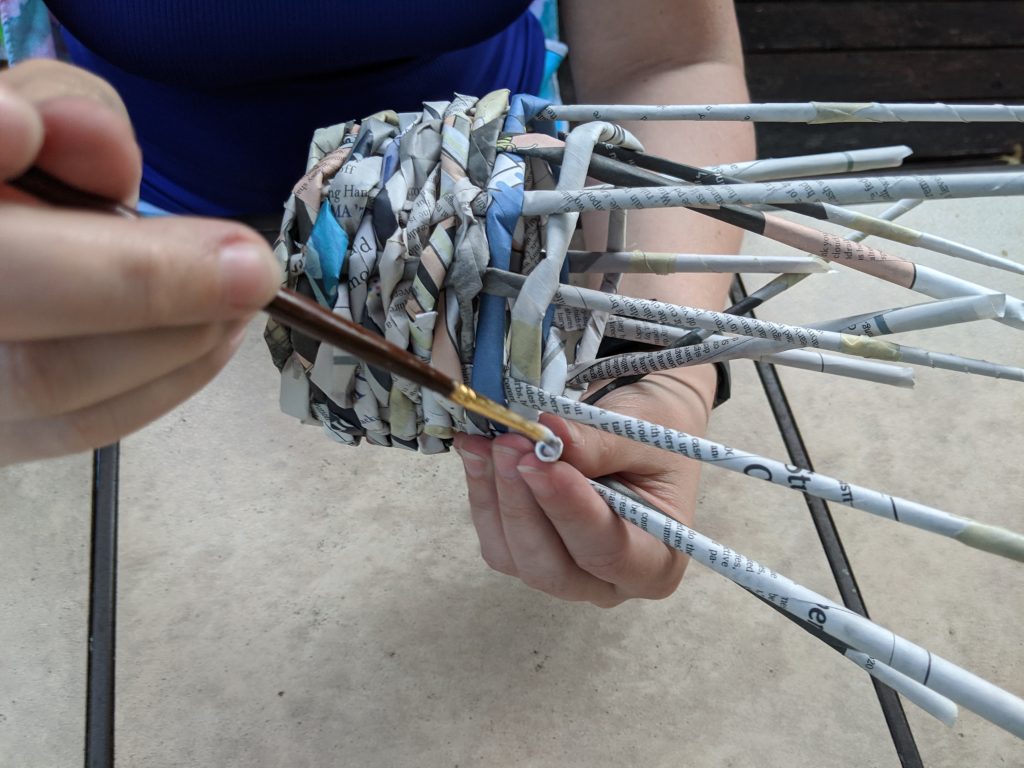
5. To add the next tube, apply adhesive inside and outside the very end of the tube you are weaving. Then place the end of a new tube over the last tube and hold in place for 30 seconds.
6. Once you have lashed the sets of spokes together by going around at least twice, you need to separate the spokes by weaving over and under each individual spoke. Having seven spokes should mean that you can continue to weave over and under all the way to the end of your basket.
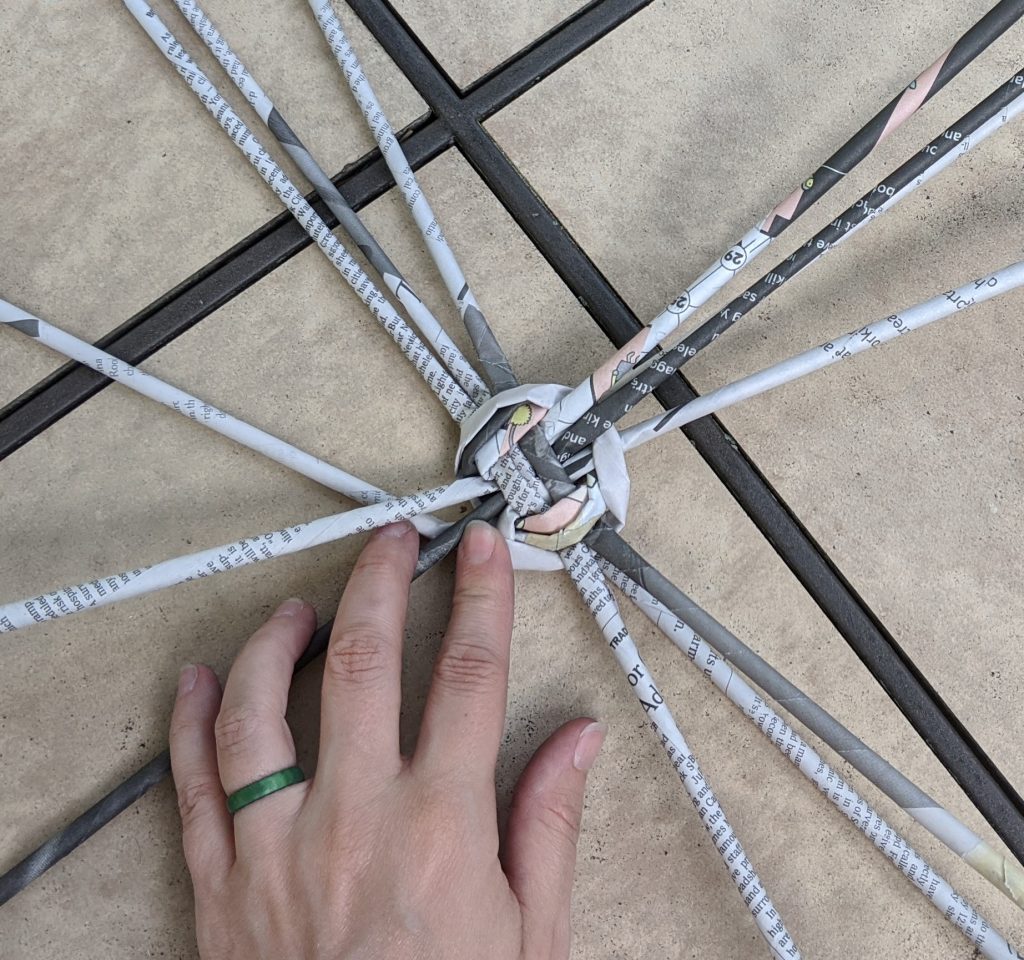
7. Create a flat “spider web”-looking base about the size of a drink coaster. Your spokes should be evenly spaced.
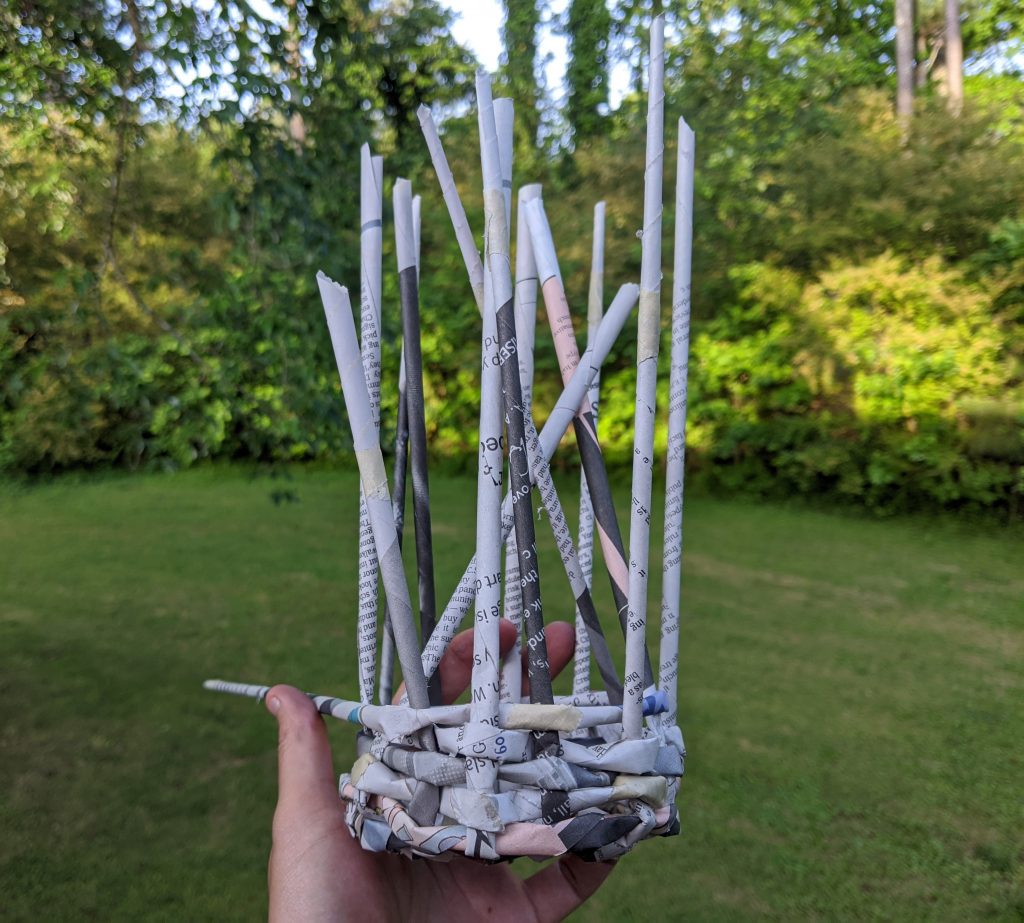
8. Next, bend the spokes upwards to create a cup shape and continue weaving.
9. Once your basket has reached about 4-5 inches tall with several inches of spoke left, it is time to end the weaving. Glue or tape the end of the last spoke to the inside of your basket.
10. To finish the ends of the spokes you can do one of two things:
A) You can use tape or glue to hold the ends down. For this technique, cut the ends short leaving about an inch sticking up and then glue or tape them down making sure that you fold the ends over the woven pieces. The spokes that finished on the inside of the basket will be folded outward and those that finished on the outside will be folded inward.
B) You can simply weave to hold your basket together. For this technique, leave the spokes long. Take two spokes, one in each hand, and fold the left behind the right. Continue around your basket, folding the left behind the right until the last spoke is threaded through the hole left from the first spoke that you folded. Tighten the spokes down. The ends of the spokes will all be pointing out from the basket. You can now snip the spokes short or tuck them back through the loops toward the inside of the basket.
11. Step back and admire your work. Great job!
Exhibit Reflection Prompts
- Describe three ways that Cherokee people used baskets during the precontact era (before Europeans arrived in the New World).
- List three local plants that are used for extracting dye to make Cherokee baskets colorful.
- Compare and contrast baskets made by the Cherokee during the precontact era with the baskets they make today. Are they used or made in a different fashion today than they were thousands of years ago?
- Compare and contrast homemade newspaper baskets with Cherokee double weave baskets. What makes a double weave basket unique?
- Is basketry an art form? Examine and interpret the basketry examples shown in the exhibit links to determine if baskets can be both functional and artistic.
- Are Cherokee and Gullah Geechee baskets traditionally made by men or women?
- Do you think that the time period, location and culture in which people make baskets influences the type of basket that they weave? Discuss how the materials used to make the basket, the basket size or style, and function would vary based on those factors.
- Compare and contrast baskets made by people in West Africa to baskets made by Gullah Geechee. What events or changes account for the differences?
- Gullah Geechee baskets are often described as sewn. Use examples of sweetgrass baskets to determine the difference between weaving and sewing.
Standards Connector
| Grade Level | Standard | Description |
| Kindergarten | SSKG1 | Describe the diversity of American culture by explaining the customs and celebrations of various families and communities. |
| Kindergarten | VAK.CN1 | Investigate and discover the personal relationships of artists to community, culture, and the world through making and studying art. b. Recognize the unique contributions of contemporary and/or historical artists and art forms, including Georgia artists. |
| Second | SS2G2 | Describe the cultural and geographic systems associated with the historical figures in SS2H1 and Georgia’s Creek and Cherokee in SS2H2. d. Describe the regions in Georgia where the Creek and Cherokee lived and how the people used their local resources. |
| Second | SS2H2 | Describe the Georgia Creek and Cherokee cultures of the past in terms of tools, clothing, homes, ways of making a living, and accomplishments. a. Compare and contrast the Georgia Creek and Cherokee cultures of the past to those of Georgians today. |
| Third | SS3H1 | Describe early American Indian cultures and their development in North America. c. Discuss how American Indians continue to contribute to American life (e.g., arts, literature). |
| 6-8 | VA6.RE.1 VA7.RE1 VA8.RE1 | Reflect on the context of personal works of art in relation to community, culture, and the world. a. Identify how the issues of time, place, and culture are reflected in selected works of art. b. Interpret works or art considering themes, ideas, moods, and/or intentions. |
| 9-12 | VAHSPA.CN.1 | Develop personal artistic voice through connecting uses of art within a variety of cultural, historical, and contemporary contexts. a. Discuss the intent of works of art in context to historical events. b. Identify universal themes that appear in works of art throughout various times and cultures. c. Analyze the ways in which personal experiences affect the understanding and appreciation of works of art. d. Investigate the role of art as a visual record keeper |
| 9-12 | VAHSPA.RE.1 | Reflect on the context of personal works of art in relation to community, culture, and the world. b. Investigate and discuss how the issues of time, place, and/or culture are reflected in works of art. |
These standards of excellence were sourced from the Georgia Department of Education web page at https://www.georgiastandards.org/Georgia-Standards/Pages/default.aspx
